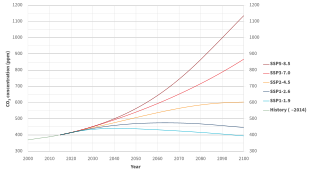
Shared Socioeconomic Pathways (SSPs) are climate change scenarios of projected socioeconomic global changes up to 2100 as defined in the IPCC Sixth Assessment Report on climate change in 2021.[2] They are used to derive greenhouse gas emissions scenarios with different climate policies.[3][4][5] The SSPs provide narratives describing alternative socio-economic developments. These storylines are a qualitative description of logic relating elements of the narratives to each other.[3] In terms of quantitative elements, they provide data accompanying the scenarios on national population, urbanization and GDP (per capita).[6] The SSPs can be quantified with various Integrated Assessment Models (IAMs) to explore possible future pathways both with regards to socioeconomic and climate pathways.[4][5][6]
The five scenarios are:
- SSP1: Sustainability ("Taking the Green Road")
- SSP2: "Middle of the Road"
- SSP3: Regional Rivalry ("A Rocky Road")
- SSP4: Inequality ("A Road Divided")
- SSP5: Fossil-fueled Development ("Taking the Highway") [7]
There are also ongoing efforts to downscaling European shared socioeconomic pathways (SSPs) for agricultural and food systems, combined with representative concentration pathways (RCP) to regionally specific, alternative socioeconomic and climate scenarios.[8][9]
- ^ Meinshausen, M., Nicholls, Z. R. J., Lewis, J., Gidden, M. J., Vogel, E., Freund, M., Beyerle, U., Gessner, C., Nauels, A., Bauer, N., Canadell, J. G., Daniel, J. S., John, A., Krummel, P. B., Luderer, G., Meinshausen, N., Montzka, S. A., Rayner, P. J., Reimann, S., . . . Wang, R. H. J. (2020). The shared socio-economic pathway (SSP) greenhouse gas concentrations and their extensions to 2500. Geoscientific Model Development, 13(8), 3571–3605. https://doi.org/10.5194/gmd-13-3571-2020 Archived 2023-04-16 at the Wayback Machine
- ^ "Climate Change 2021 - The Physical Science Basis" (PDF). ipcc.ch. Archived (PDF) from the original on 13 August 2021. Retrieved 15 August 2021.
- ^ a b "Shared Socioeconomic Pathways (SSPs)" (PDF)..
- ^ a b Cite error: The named reference
:2was invoked but never defined (see the help page). - ^ a b Rogelj, Joeri; Popp, Alexander; Calvin, Katherine V.; Luderer, Gunnar; Emmerling, Johannes; Gernaat, David; Fujimori, Shinichiro; Strefler, Jessica; Hasegawa, Tomoko; Marangoni, Giacomo; Krey, Volker (2018). "Scenarios towards limiting global mean temperature increase below 1.5 °C". Nature Climate Change. 8 (4): 325–332. Bibcode:2018NatCC...8..325R. doi:10.1038/s41558-018-0091-3. hdl:1874/372779. ISSN 1758-678X. S2CID 56238230. Archived from the original on 2022-04-23. Retrieved 2022-04-23.
- ^ a b "SSP Database". tntcat.iiasa.ac.at. Archived from the original on 2020-04-25. Retrieved 2019-11-09.
- ^ Hausfather, Zeke (2018-04-19). "Explainer: How 'Shared Socioeconomic Pathways' explore future climate change". Carbon Brief. Retrieved 2019-09-13.
- ^ Nishizawa, Takamasa; Kay, Sonja; Schuler, Johannes; Klein, Noëlle; Conradt, Tobias; Mielewczik, Michael; Herzog, Felix; Aurbacher, Joachim; Zander, Peter (2023-07-22). "Towards diverse agricultural land uses: socio-ecological implications of European agricultural pathways for a Swiss orchard region". Regional Environmental Change. 23 (3): 97. Bibcode:2023REnvC..23...97N. doi:10.1007/s10113-023-02092-5. ISSN 1436-378X. PMC 10363045. PMID 37489177.
- ^ Nishizawa, Takamasa; Kay, Sonja; Schuler, Johannes; Klein, Noëlle; Herzog, Felix; Aurbacher, Joachim; Zander, Peter (2022). "Ecological–Economic Modelling of Traditional Agroforestry to Promote Farmland Biodiversity with Cost-Effective Payments". Sustainability. 14 (9): 5615. doi:10.3390/su14095615. hdl:20.500.11850/548714. ISSN 2071-1050.